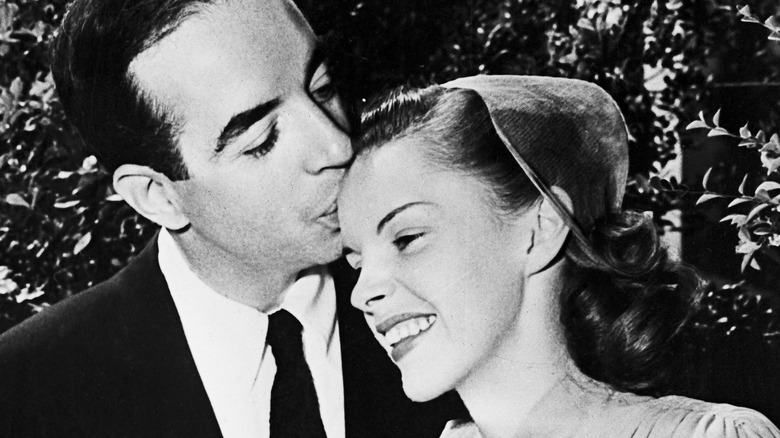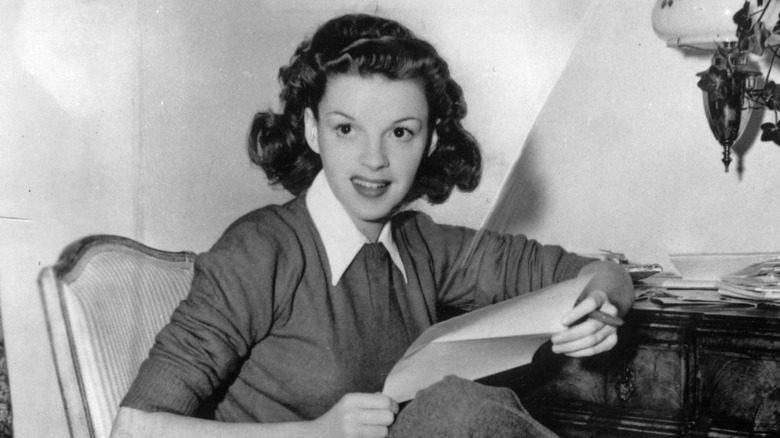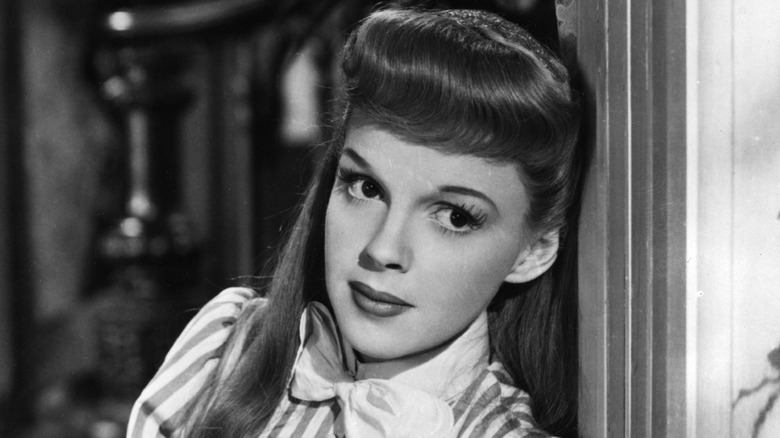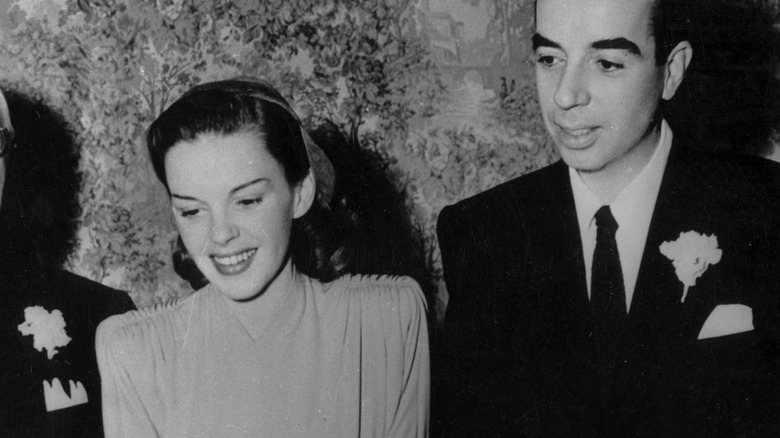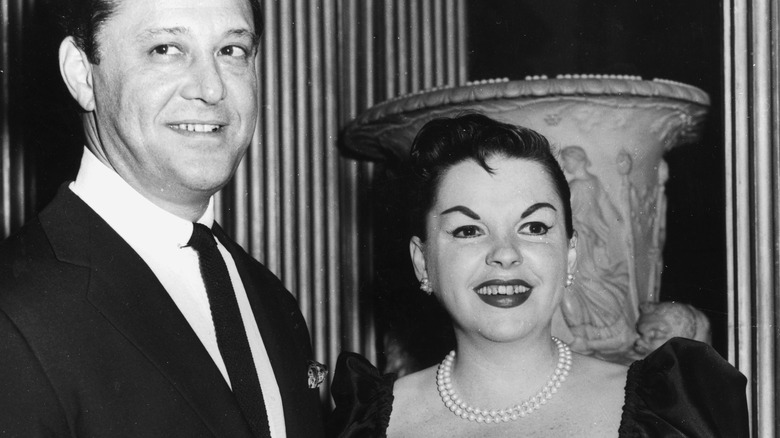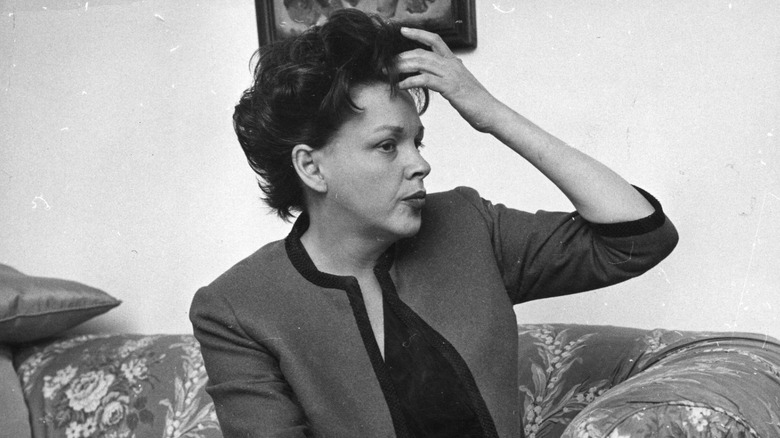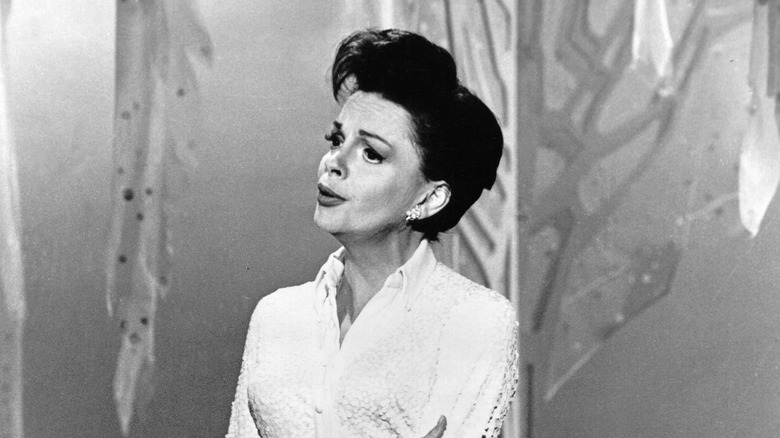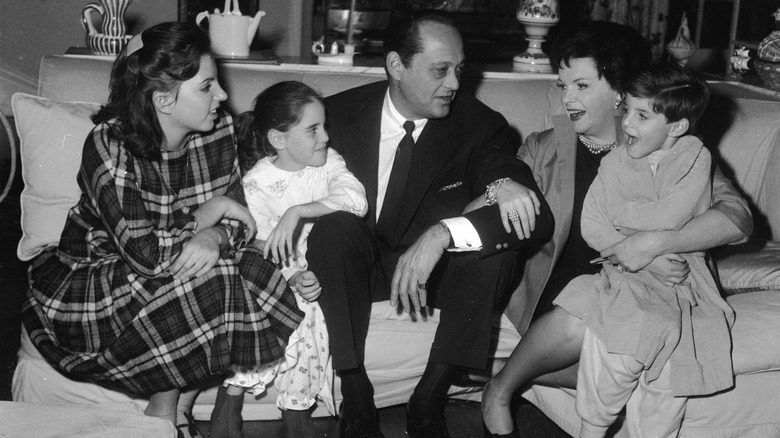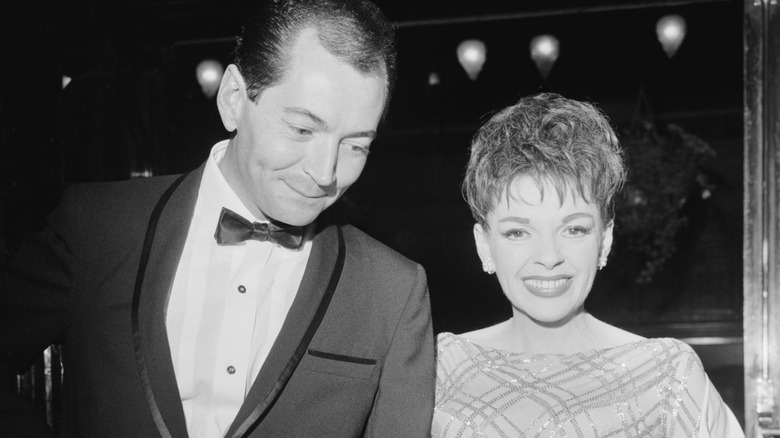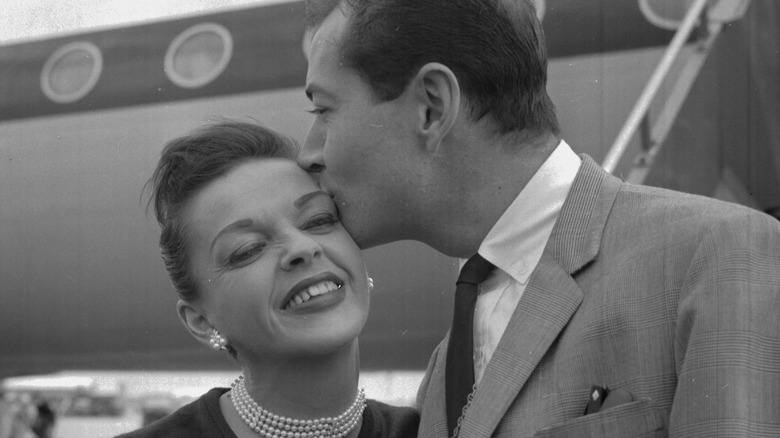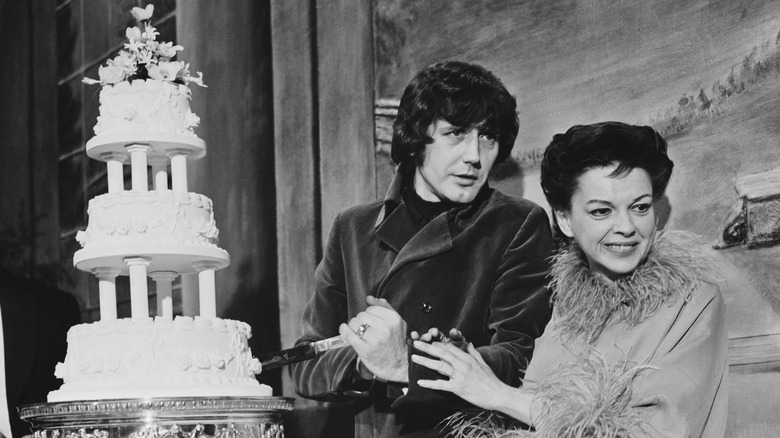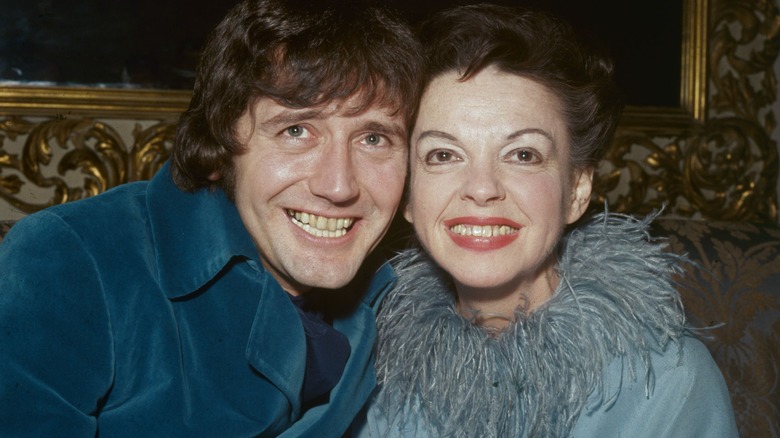The Sad Truth About Judy Garland's Marriages
Judy Garland was a talented star most known for her role as Dorothy in the 1939 film "The Wizard of Oz." She won numerous awards during her career, including an Oscar, a Tony, and a Grammy. She made over $100 million for MGM, according to Britannica, making her the studio's most profitable star. She was also a successful recording artist, producing numerous best-selling songs. While her professional life was extremely successful, her personal life was filled with turmoil. Garland struggled to make permanent connections with the men that she loved, largely due to her dependence on drugs and alcohol. But her husbands, too, also had problems that contributed to their bad marriages.
In a 1967 interview, Barbara Walters asked Garland what she imagined she would be other than an actress, and Garland replied, "Happily married." When asked if she thought she could be both an actress and happily married, Garland said, "I don't think anybody who married me thought so, but I think it's possible." She then reasoned that men didn't realize how difficult it would be to be married to her.
Garland wed five men before her death at 47. She was a teenager the first time, and she was a newlywed when she died during her fifth marriage. While she had a fairytale career, real life did not follow suit. Read more about the tragic circumstances surrounding Garland's ill-fated marriages.
This article contains references to substance abuse, mental health issues, and emotional and physical abuse.
She was a teen when she married David Rose
Judy Garland married her first husband, David Rose, in 1941. She was only 19 years old and had an extremely successful career as Metro-Goldwyn-Mayer's golden girl. Rose was an arranger and composer, and they shared a love of music. The pair met during a radio broadcast and quickly fell in love, according to Architectural Digest. Her mother and MGM head Louis B. Mayer objected to the match because Rose was divorced and more than a decade older than Garland. Dubbed "that baby" by Mayer, Garland was also marketed as an innocent star without the sexual desire that was normal for a young woman her age to have.
Garland's mother finally relented to the match, and she threw her daughter a huge engagement party. The couple wed in Las Vegas six weeks later. They moved into a home in Bel-Air near Garland's mother and not too far from the MGM soundstage. The newlyweds were quite happy, and married life was just as Garland has envisioned — at least at the beginning. She was later quoted as saying, "I do like to be in love. A woman is incomplete when she's not in love." However, her happiness did not last.
David Rose pressured her to have an abortion
Within a year of their marriage, Judy Garland was miserable. She later described herself as being only 13 years old emotionally. Plus, she didn't know how to take care of a home, like women of that era were expected to do. Even though she and Rose both liked music, the shared interest wasn't enough to sustain their relationship. The pair's age difference was a big problem. Garland was young and enjoyed being social, going to nightclubs and attending parties. She also loved to dance. Rose acted older than his 31 years and preferred playing with his miniature train that could accommodate 12 people, according to Architectural Digest. While he was content to spend time tinkering with his train at home, Garland wanted to spend her downtime with friends.
Things may have turned out differently had Garland and Rose raised a family. However, when Garland found out that she was expecting, her mother insisted she terminate the pregnancy. Rose also objected to his wife having a child, so Garland did as she was expected to do. Her relationship with Rose changed after that decision. She later told a friend, "Something was gone," and the couple decided to divorce. A colleague from MGM even penned some lyrics about their doomed marriage to go along with Rose's melody from the song "Holiday for Strings." The lyrics included, "Oh, see the little violins/Enjoying sunshine at the shore/They're rid of David Rose, the bore."
She had mental health breakdowns during her marriage to Vincente Minnelli
Judy Garland married director Vincente Minnelli in her mother's home on June 16, 1945, according to The New York Times. She starred in Minnelli's film "The Clock," one of her first adult roles as a romantic lead and a critically acclaimed performance. Unfortunately, their marriage was fraught with problems. Her third husband, Sid Luft, wrote about Garland's tumultuous second marriage in his autobiography "Judy and I." According to Luft, Garland felt like Minnelli wasn't helping her with her career. She told him that "Vincente was not capable of being a protector or husband in the deepest sense."
According to The New Yorker, one of the major issues was Garland's emotional instability and her addiction to drugs. When she was a child star, MGM gave Garland amphetamines in order to keep her energized during long days on set. Garland's behavior, which included multiple suicide attempts, became a problem for her career. MGM fired her from the films "The Barkleys of Broadway," "Annie Get Your Gun," and "Royal Wedding" and released her from her contract.
If you or anyone you know needs help with addiction issues, help is available. Visit the Substance Abuse and Mental Health Services Administration website or contact SAMHSA's National Helpline at 1-800-662-HELP (4357).
Sid Luft acted horribly when she got pregnant and he didn't want the child
Judy Garland was nominated for the Best Actress Oscar for her role in the 1955 film "A Star Is Born," produced by Sid Luft, her third husband. The two first met nearly 20 years earlier when the actress was a teenager and before she starred in "The Wizard of Oz," according to The New Yorker. They reconnected in 1950 when they were both married, and ended up working together. While she believed her second husband Vincente Minnelli wasn't helping further her career, Luft appeared to be a better promotor. However, he was so focused on work that he coerced Garland into making some difficult personal choices.
When Garland got pregnant in 1951 with her and Luft's baby, the producer suggested she terminate it. He wrote in his memoir that they were busy working on a show together at Broadway's Palace Theater in New York City. He wrote, "How could she have been so foolish? – That was my attitude. I was as unjustified as I was insensitive." He was afraid that the news would be disastrous for the show and generate bad publicity because they were both still married to other people. Garland had an abortion and wound up winning a Special Tony Award for the performance, cementing her status as a showbiz icon.
Sid Luft enabled her drug addiction
Judy Garland's misuse of drugs didn't stop even though she had a new man in her life. During her relationship with Sid Luft, Garland had a problem with prescription drug abuse. Luft, however, believed he could manage the problem. He explained in his memoir that in 1952 he wasn't looking at Garland as "clinically ill" or an "addict." Instead, he was "worried something awful had happened to the delightful, brilliant woman I loved." They both finalized their divorces and wed in July of that year.
Garland gave birth to their daughter, Lorna Luft, in November 1952. Unfortunately, Garland struggled with postpartum depression, according to The New Yorker. And one of the ways doctors dealt with that type of condition is by prescribing medication. Garland was self-medicating at the same time, so the combination created a problem for her both mentally and physically. In addition to amphetamines, Garland took diet pills in order to stay thin for work. Luft tried to "manage" her medication just like he managed her career and, in hindsight, realized his mistake: "I was enabling — a lesser version of what MGM had blatantly and inhumanely jammed down her throat."
If you or anyone you know needs help with addiction issues, help is available. Visit the Substance Abuse and Mental Health Services Administration website or contact SAMHSA's National Helpline at 1-800-662-HELP (4357).
Garland attempted suicide several times during her marriage to Luft
In the early '50s, the depression was so bad that Judy Garland attempted to take her own life. When he heard what she had done, her husband Sid Luft quickly returned home. He wrote in his memoir that he was convinced that Garland was going to die. Fortunately, doctors arrived quickly and saved her life. The incident had a great effect on Luft's perception of his wife's "demons." He didn't understand why she acted in such a way when life seemed so good. He wrote, "It was a gigantic puzzlement that she would poison herself with pills, and that the toxic reaction to whatever she swallowed would create an impulse for self-mutilation."
Several years later, Garland again attempted suicide while staying at a hotel in Washington, D.C. Luft recalled, "When Judy came out in her short white lace negligee, her arms were in front of her and she said, 'Look, darling, what I've done!' Her wrists had been slashed and she was bleeding profusely." He was able to put tourniquets on her arms and sought medical attention to save her life.
If you or anyone you know is having suicidal thoughts, please call the National Suicide Prevention Lifeline by dialing 988 or by calling 1-800-273-TALK (8255).
Garland claimed Luft physically abused her
Judy Garland may have had issues during their marriage, but Sid Luft also contributed to the unsettled environment in their home. The couple split up numerous times during their relationship, and according to the producer's 2005 obituary in The New York Times, during divorce proceedings in 1965, Garland claimed that Luft was physically abusive. She told Judge Edward R. Brand of Superior Court that Luft had a penchant for drinking, and she stated, "He struck me many times."
Later, Luft tried to capitalize off of his relationship with Garland. In 1993, he attempted to auction off the Academy Juvenile Award she won for the iconic 1939 film "The Wizard of Oz." Was he doing so for the money? The Academy of Motion Picture Arts and Sciences filed a lawsuit against Luft and won. The organization has a clause in which an award winner "shall not sell or otherwise dispose" of an Oscar and cannot "permit it to be sold or disposed of by operation of law," reports Business Insider. This also pertains to anyone who inherits a statue from an Oscar winner. In addition, Luft published a memoir of his life with Garland titled "Judy & Me: My Life With Judy Garland," from which he certainly earned some money and which came off as exploitative.
If you or someone you know is dealing with domestic abuse, you can call the National Domestic Violence Hotline at 1−800−799−7233. You can also find more information, resources, and support at their website.
Her marriage to Mark Herron lasted just a few months
Judy Garland refused to give up on love despite having three failed marriages. While she and Sid Luft didn't divorce until 1965, there were rumors that she had bigamously married her fourth husband, Mark Herron, in the summer of 1964, according to The Los Angeles Times. At the time, Garland's manager, Freddie Fields, refuted the buzz that she had tied the knot explaining that she was still married to Luft. Contradicting her manager, Garland claimed the following day that she had, in fact, married Herron, calling the marriage "absolutely legitimate."
Officially, Garland and Herron got married in Las Vegas in November 1965, which timewise makes sense because it occurred after her divorce from Luft. Unfortunately, the union was not a good one, and the pair split a short time afterward. During court proceedings 17 months later, the actress claimed Herron was physically abusive. He defended himself by saying he did hit her but only did so in self-defense.
If you or someone you know is dealing with domestic abuse, you can call the National Domestic Violence Hotline at 1−800−799−7233. You can also find more information, resources, and support at their website.
Both Vincent Minnelli and Mark Herron were gay, complicating those marriages
Emmanuel Levy, author of the Vincent Minnelli biography "Vincent Minnelli: Hollywood's Dark Dreamer," writes that Judy Garland'ssecond husband was "openly gay" before he moved from New York to the West Coast. No doubt, being attracted to men may have put a challenging spin on their marriage. Levy explained (via Biography): "We were able to document names of companions and stories from Dorothy Parker. But when he came to Hollywood, I think he made the decision to repress that part of himself or to become bisexual." Garland reportedly discovered his relationships with men and attempted suicide after catching him once in the act.
Her fourth husband, Mark Herron, was also gay, according to multiple online sources, which in addition to his abusive behavior, was one of the causes of their divorce. Nathaniel Frank, an LGBTQ public policy expert and author of "Awakening: How Gays and Lesbians Brought Marriage Equality to America," told EW he explained that emotionally damaged people like Garland sometimes "would end up in relationships with people who can't give them fully the emotional lives that they might otherwise yearn for."
She married Mickey Deans just three months before her death
Perhaps the fifth time's the charm? After four failed marriages, Judy Garland decided to give it another (and final) shot with a man named Mickey Deans. She fell head over heels for Deans, revealing in what would become her final interview that she didn't have a rich life until Mickey came along. She explained, "I'm happily married to a man who is about to give me the protection and help I need, and I can just do a concert now and then, when I feel like it." She added that Deans provided companionship when she finished performing for the night: "Now I can go home with my husband and that's much nicer."
Unfortunately, their love affair was short-lived. Just three months after they tied the knot, Garland died, according to The Wrap. The cause was an accidental overdose of barbiturates. The coroner did not find any drug residue in her stomach, indicating that she had been using them for a prolonged period of time and not all at once.
Mickey Deans reportedly forced her to perform
Judy Garland met her fifth husband, nightclub manager Mickey Deans, in 1966 after he brought drugs to her at her hotel, according to Time. Three years later, they tied the knot in London. Despite Garland gushing about him in her final interview, the relationship had its problems, just like her previous ones did. For example, Deans allegedly coerced her into performing during her London stint, six shows a week over the course of five weeks, even though she didn't feel well. According to the Judy Garland tribute artist Peter Mac in the Huffington Post, doctors had ordered her not to perform, yet she did so anyway due to Deans' influence.
In addition to being emotionally abusive, Deans was also verbally abusive to Garland. Plus, he allegedly tried to sell her personal items and jewelry, or at least pieces he claimed belonged to her but, in fact, were items he purchased at thrift shops and garage sales. Daughter Lorna Luft wrote in her memoir "Me and My Shadows: A Family Memoir" (via The Wrap), that after her mother's funeral, Deans reportedly needed to stop to finalize a book deal about Garland. "I don't know if it was true, but his book did come out a couple of years later under the title, 'Weep No More, My Lady.' Needless to say, I didn't buy a copy. Mickey Deans. What a putz," she wrote.
